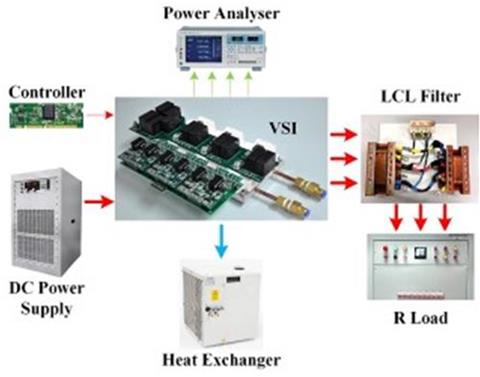Research Highlights
Compact EMI Filter for High Power Density Converter
With more electrical engines replacing mechanically driven systems, there is a continuous trend for higher electrical power demand on the aircraft. Given the weight and space constraints, the power converter must be light weight and compact, hence giving rise to the need for high power density converter (HPDC).
Similar to any switching power converters, the EMC design has to be taken into consideration. The electromagnetic interference (EMI) filter is a necessary interface between the aircraft power grid and HPDC to suppress EMI noises generated by the high frequency switching devices. By adopting advanced passive integration and packaging technologies, the size of EMI filter, which is too bulky for HPDC, can be made highly compact without compromising in EMI suppression performance.

Feasibility Study on Small UAV with Compact Rectenna Module Powered by Microwave Beam from Ground
A feasibility study on powering small commercial unmanned aerial vehicle (UAV) with microwave beam was proposed. The project objective is to develop a power-efficient microwave power receiving system for small UAV and perform feasibility study on powering small UAV with microwave beam. The challenge is to make the receiving system space-efficient and light-weight, so that the system can be easily integrated onto the UAV without introducing too much extra payload. Also, the system needs to be highly directive to increase reception efficiency.
A completed microwave power receiving system consisting of the patch antenna arrays, rectifiers and power management circuit has been designed, integrated and tested. Its functionality to receive and convert the microwave power to DC power for charging a UAV has been demonstrated.

Compact Rectenna Array for Wireless Energy Harvesting
Wirelessly powered, portable electronic devices can be deployed in large number and placed into harsh environment with limited human access. An example is the sensors in wireless sensor network (WSN) for smart building and health monitoring applications. The researchers at EMERL has developed a design methodology that realises a compact dual-element antenna array on package. Not only will this achieve high compactness by bringing the array elements closely together, it also reduces the inter-coupling between the array elements so that the rectenna enhances the RF power receiving capability for energy harvesting purpose.
Reduction of Bearing Degradation in Marine-Based Systems
The increase in bearing current related failures is due to a widespread use of the pulse-width-modulated (PWM) converter based variable-frequency drives (VFDs) to control AC machines in marine-based applications. Electric motors powered by modern VFDs are subjected to high-frequency voltage pulses relative to ground, and results in unwanted capacitive-coupled currents, such as stator-to-rotor (purple), stator-to-frame (brown), rotor-to-shaft (blue), and high-frequency circulating (red) currents shown below. This project will investigate bearing degradation in low- and medium-voltage marine drives with a goal to identify and implement effective protection methods against bearing degradation using computer modeling and hardware demonstration.

Power Distribution Network and Signal Integrity Design for High Speed Electronics
With advancements in technology, high speed circuits operate at a higher speed, and supply voltage to integrated circuits (ICs) also continues to reduce for low power devices. While these changes make the circuit more powerful and power-efficient, they also pose design challenges on the power distribution network.
Due to the tight margin on supply voltage fluctuation and transmission line-like behavior of interconnects, parasitic elements introduced by discontinuities such as via and bend becomes significant and may jeopardise the functionality of the circuit. As such, there is a need to develop a design methodology that can guide circuit designers to handle these issues with minimum design iterations, for compliance with power integrity (PI) and signal integrity (SI) requirements.
Sea-Water Monopole Antennas of High Radiation Efficiency
Sea-water is good conductor at HF and VHF frequency bands and it can be potentially very useful for antennas operating at these bands. Sea-water antennas are transparent and easily reconfigurable. Although much work has been conducted for static-type sea-water monopoles, dynamic-type sea-water monopoles suffer from low radiation efficiency due to the direct contact between the radiating monopole and ground because both are made of sea water.
In this project, a new feeding structure has been proposed to greatly enhance the radiation efficiency of dynamic-type sea-water monopole antennas. Shown in the figures below, a dynamic-type sea-water monopole has been designed and tested. Its measured radiation efficiency can reach 56.2% at 56.5 MHz under a real sea environment. It is believed that such an antenna can be potentially very useful for maritime communication systems. Other types of sea-water antennas are currently under investigation.


